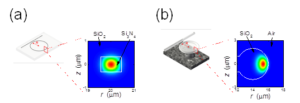OSA (FiO/LS) 2015 大岡 勇太
الأبحاث
REPORT OF FRONTIERS IN OPTICS 2015
October 18 – 22, 2015
San Jose
يوتا أوكا
1.Abstract
This conference is 99th annual meeting and will be held in New York next year. Many events were included, such as main technical presentations, tutorial session, industry demos, banquet, networking lunch (I didn’t attend). There were, of course, a lot of attendants who work on optics. This was the second time for me to attend the conference in foreign country. I felt that the attendants looked excited and I was very motivated as I was at my first attendance to foreign conference.
I got knowledge through listening to presentations. Therefore, I am going to share some of the beneficial researches for our group in the following parts. I thought that major interest was on plasmonics, imaging and quantum-optics through entire sessions.
2.Review of my presentation
The session in which I presented had presenters and audience which had deep knowledge in our field, which made the discussion part active and beneficial. I got questions about the regimes of disorder, the prediction of localizing place and the switching contrast in the discussion part. I could take some questions directly just after my presentation because I was the last in the session. First question gave me new point of view. The question was if the maximum contrast of E/O modulate is supposed to be between the peak and background of resonance. I think the answer is yes considering my switching system. That means the contrast is up to 15 dB. We should think if it is enough. The second question was about the way to create the illustration I made with Pov-ray. I was happy because I could have confident on the illustration.
3.Beneficial researches
Periodic Silicon Ridge Waveguides Exhibiting Degenerate Band Edge Resonances
The Ohio State University
Around the photonic band edge, we observe multiple fluctuation. Those are called band edge resonances, which I didn’t know before the presentation. The origin of the resonances are Fabry-Pérot cavities. Since we use hexagonal lattice two-dimensional photonic crystal, it is hard to find Fabry-Pérot cavities in it. In the typical study of the photonic band edge, however, they use one-dimensional photonic crystal.
This group fabricated 1D photonic crystal ridge waveguides. We can find that there is a gap, z0, in the phase of periods between lower and upper cases of photonic crystal holes rows. z0 changes the dispersion curve and degenerates different type of band edge resonances. Q-factor degenerated with this procedure is proportional to N5 instead of N3 in regular band edge resonances, where N is the number of photonic crystal periods.
Optomechanical Crystals Fabricated by a CMOS Foundry
University of Campinas, Brazil
As we fabricated photonic crystals with CMOS commercial foundry, IME in Singapore, they fabricated it in IMEC in Belgium. They designed two different types of PhC nanocavities called as multi-hetero cavity with and without a slot in a PhC waveguide. The design without a slot shows the highest intrinsic Q of 9.1×105. And also they measured optomechanics included in PhC with a slot.
Tuning and imaging random photonic modes
European Laboratory for Non-linear Spectroscopy, Italy
This talk was invited one. A random photonic crystal can be used to observe photon line when quantum dot are embedded in it. The frequencies of PL are tuned finely with partially oxidant photonic crystal. The position of oxidation is decided with SNOM observation.
Optical Interconnects for Computing Systems and the Need for Integration
IBM research, Switzerland
I introduced this research in our journal club in December. The important point is that they succeeded demonstrating polymer waveguide in 1550 nm regime. The propagation loss is less than twice compared to 780 nm polymer waveguide. In this presentation, they showed adiabatic coupler which has high robustness against fabrication error. This waveguide will be able to integrate fibers which are now transport light between chips with board circuits.
4.Additional story
I attended the banquet for OSA members on Tuesday. It was buffet style. There was a circular table surrounding a pillar and many kinds of foods were on the table. Participants gathered and rotated around the table taking foods. I had no chance to join the circle line and take food. I asked one who had aleady taken food from the table how he took it. Then, he answered me “You should couple the circular rotating line evanescently. It’s a whispering gallery dinner!” I was amazed by the answer because I thought that that kind of joke made sense just in Japan. “It’s not only funny in Yagami, but in whole world! (Actually he was European.)” I am kind of relieved because I am sometimes freaked out when I hear jokes based on Science in my university.
- تصنيفات
- 国際会議報告



